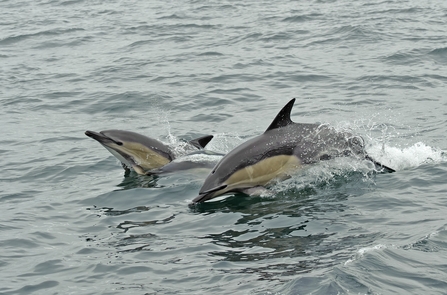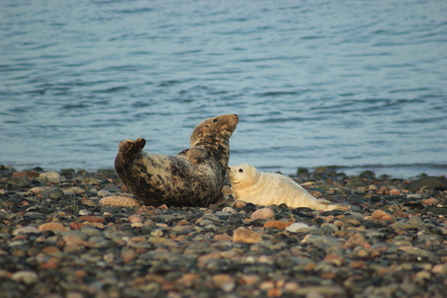
We spotted five common dolphins off the coast of Cumbria in 2021 © Chris Gommersall/2020VISION

We spotted five common dolphins off the coast of Cumbria in 2021 © Chris Gommersall/2020VISION
From vibrant sea slugs to hook-nosed sea pigs (more commonly known as grey seals!), the Irish Sea coast off Cumbria is home to some truly wonderful wildlife. Our marine team, in collaboration with other North West Wildlife Trusts, are working hard to protect wildlife and habitats throughout the Irish Sea. Here they share some of their memorable marine moments, both highs and lows, and some surprising sea sightings of 2021.
The wonderfully-named scarlet lady and highland dancer are both sea slugs. Both were sighted off Walney this year. As its name suggests, the scarlet lady is a brightly coloured sea slug – the one spotted in the seagrass meadows of the Walney Channel was a vibrant coral pink. Unlike your regular garden slug, this particular sea slug can incorporate the stinging cells from its prey into its own body, giving it a cunning defence against predators!

Scarlet lady sea slug © Emily Baxter
The highland dancer sea slug was spotted by Lynn Murdoch at Thorny Beach, Walney. They’re so named because of the energetic dance-like motion they make as they move along. They send a wave through their 'foot' (not quite a kilt) to propel themselves in a rather ungainly gait. Nevertheless, their spotted surface and iridescence makes them a mesmerising spectacle to behold! This is the first record of this species in Cumbria and fewer than 400 of these large sea slugs have been recorded in the UK and Ireland in 100 years.
There are more than 100 species of sea slugs (or nudibranchs – meaning naked gill, as they have no shell or coverings to protect them) found in UK seas, where they feed on seaweeds, sea mats, sponges, anemones and other nudibranchs. Nudibranchs come in many colours and forms, often with two horn-like tentacles or feathery gills.
Sadly, there were several reports of sea life strandings on our beaches this year. In March there was a mass stranding of cuttlefish along the North West coast, with members of the public reporting thousands of cuttlebones washing up, from Wales up to Cumbria.

Cuttlefish bones © North Wales Wildlife Trust
Dr Emily Baxter, Senior Marine Conservation Officer for Cumbria Wildlife Trust said: “There are a number of possible explanations for this and to make it more difficult to identify, there is a potential delay from the animal’s death to being washed ashore, making assigning a cause more difficult. There was a mix of weathered and fresher bones, of differing sizes. Cuttlefish usually breed in late spring and summer and it’s natural that the adults die after breeding. The fact that they washed up in such numbers in March could be due to windy weather bringing in the bones, which may have been building up in the depths over time.
“At the time of the strandings there had been extremely high volumes of flood water travelling downstream (carrying debris and high levels of run off and pollutants such as nitrates) at a critical time when the eels may have started their seaward migration journey. It is difficult to know whether this could explain why the eels washed up dead on the beach. Unfortunately, European eels are classed as critically endangered and face many threats on their migration, including human barriers, disease and parasites, exploitation, habitat loss, pollutants, and predation.”
"Any small bones could have come from late breeding the year before and the smallest ones getting caught out, having been unable to reach a mature size. The good condition of many of the bones suggests it could have been a more recent mortality event, perhaps caused by weather conditions or lack of food. The quantity and the widespread nature of the strandings means that it’s unlikely to be due to on-ship processing from bycatch of the fishing industry.”
You may have seen the chalky internal shells of cuttlefish, called a cuttlebone, washed up on the beach. These are often used in budgie cages, as a calcium-rich dietary supplement for the bird. Cuttlefish can grow up to 45cm and are actually related to squid and octopuses – a group of molluscs known as cephalopods. These amazing creatures can quickly change colour and texture to merge into their background, distract predators or attract mates. They can easily mimic different types of seabed and will sometimes even sink into a sandy seabed to hide from predators, leaving only their eyes exposed.
Other unusual strandings have happened throughout the year. In November, Helen Hammond reported that she'd come across eight or nine large eels, approximately two to three feet long, that had washed up dead on Askam-in-Furness beach near Barrow, and she found more the following day. Again, without more information, including water and fish samples, it can be hard to determine the cause of death. Dr Baxter explains: “Each autumn, European eels leave our rivers and travel across the Atlantic Ocean to breed in the Sargasso Sea and then, they die. Young and tiny glass eels take two to three years migrating across the ocean, back to our coasts and before travelling up river. Adult eels have been shown to begin their migration down our rivers between August and December before heading across the Atlantic.

Sea potato shells © Mike Sturt
Following Storms Arwen and Barra in December, there was a mass stranding of sea potatoes at Sandscale Haws on the Duddon Estuary. Sea potatoes are a type of sea urchin that is perfectly adapted for life in the sand. They live in a burrow in the sand, feeding on dead animals and plants using their tube feet! They are covered in golden spines, which give them a furry appearance. When they die their white, brittle, empty shells (called ‘tests’) can be found washed up on the beach. The shape of these shells also gives them the slightly nicer name of heart urchins.
A total of 10 dolphins were spotted off the coast of Cumbia near Whitehaven this year, five bottlenose and five lesser-seen common dolphins, on our first My Local Catch sea watch survey. My Local Catch is a project based in Whitehaven to raise awareness of sustainable fishing methods that don’t damage precious underwater wildlife and habitats.
Common dolphins are an offshore species, but often come close to shore to feed. These energetic animals are sociable and will sometimes approach boats, bow riding and leaping alongside. They can reach swimming speeds of around 30 miles per hour when chasing food or bow riding! There will be more opportunities to get involved with sea watch surveys next year – keep an eye on our events page.

Grey seals at South Walney © Cumbria Wildlife Trust
Finally, Cumbria’s only grey seal colony had a great year, with a record number of 518 seals being counted by drone at South Walney Nature Reserve in February. The previous highest number recorded on a survey was 483 seals (March 2019), and prior to that, 360 was the highest count in January 2018.
Dr Baxter explains that the seal colony is thriving not down to luck but thanks to the protective measures that we have put in place: “Staff and volunteers at South Walney Nature Reserve have worked really hard to make sure the colony of grey seals is protected from disturbance from people and dogs, as the beaches are closed to the public.”
We remind everyone that the best way to enjoy the grey seals is to watch the live streaming seal cam. If you wish to visit South Walney Nature Reserve, please note that the beaches where the seals haul up are not open to the public. You can see the seals from a safe distance, from one of the hides at South Walney.
A total of seven seal pups were recorded at South Walney Nature Reserve this year. The first seal pup of the season took everyone by surprise, arriving in August instead of October, as usual. It could be that a new seal had come to breed at Walney for the first time. Dr Baxter says: “The early arrival could be an indicator that there was lots of food around for the seals this summer and that the female’s body was in a good condition to be able pup, and that she was maybe taking advantage of the good weather, as female grey seals don’t feed much while nursing their pups. They can lose as much as 65kg in body weight in a few weeks while their pups put on around 2kg per day feeding on their fat-rich milk.”

Grey seal and pup at South Walney Nature Reserve © Emily Baxter